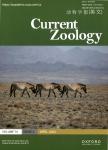Effects of environmental variability and offspring growth on the movement ecology of breeding Scopoli's shearwater Calonectris diomedea
Effects of environmental variability and offspring growth on the movement ecology of breeding Scopoli's shearwater Calonectris diomedea作者机构:ISPRA- Institute for Environmental Protection and Research Ozzano dell'Emilia Italy Conservation Department LIPU-BirdLife Italy Parma Italy ISAC-CNR - Institute of Atmospheric Sciences and Climate Consiglio Nazionale delle Ricerche Torino Italy
出 版 物:《Current Zoology》 (动物学报(英文版))
年 卷 期:2014年第60卷第5期
页 面:622-630页
核心收录:
学科分类:0710[理学-生物学] 1008[医学-中药学(可授医学、理学学位)] 07[理学] 0905[农学-畜牧学] 0906[农学-兽医学] 071002[理学-动物学] 10[医学]
基 金:Italian Ministry of Environment LIPU-UK National Park of Tuscan Archipelago
主 题:养殖场所 运动行为 环境变化 生态影响 海鸥 后代 长途旅行 生态质量
摘 要:Most seabird species display colonial behavior during the breeding period which implies that food resources around breeding sites can easily go depleted. Seabirds need to both reach profitable areas, which can be located far from the colony, and return to the colony regularly. In this context, flexibility in movement behavior may be crucial for breeding success. During chick-rearing, Procellariformes species can alternate short trips lasting 1–4 days for chick provisioning with longer trips for self-provisioning in what has been called a dual-foraging strategy. We analyzed foraging trips from 136 Scopoli’s shearwaters from three Mediterranean colonies tracked with GPS during 6 chick-rearing seasons to assess whether the adoption of a dual foraging strategy depends on the quality of habitat surrounding the colony. We found a marked dual-foraging strategy only in birds from the Linosa colony which was the largest colony in terms of breeding pairs and was characterized by having a lower marine habitat quality. Birds from this colony performed foraging trips that extended up to 369 km from the nest and lasted more than 10 days. In general, the decision to perform long lasting trips was triggered by lower values of primary production and higher offspring weight. Contrary to expectation, the decision to feed far from the colony was not related to the parents’ weight. At the same time, despite the higher productivity offered by distant areas, the higher proportion of long trips performed by birds breeding in poor areas was not sufficient to maintain the same body mass as the ones breeding in richer areas.



